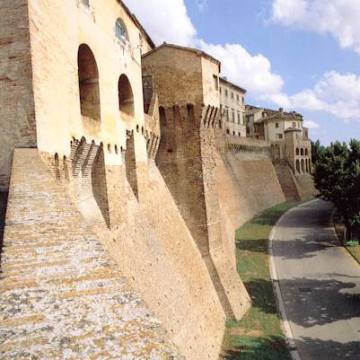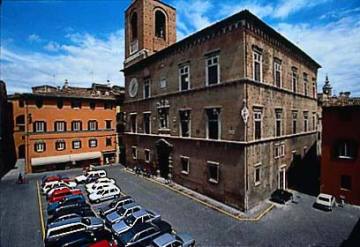|
This thriving and elegant centre is one of the most beguiling towns in this stretch of the Marche and boasts a sophisticated old centre and lively cultural
life that has earned it the nickname "Milano of the Marche".

Its most striking feature greets you as you arrive - a belt of massive 14thC walls (above), built on Roman foundations, strengthened with buttresses and
impregnable towers, and topped by houses. The main streets of the walled historic centre run along a narrow ridge and there is much to tempt you to explore.
Start in Piazza Federico II which lies at the north-eastern end of the town where the Roman forum of Aesis once lay. Its name recalls the birth here of the
fabled medieval Hohenstaufen Emperor Frederick II in a tent on 26 December 1194. Frederick, known as Stupor Mundi for his stirring deeds, endeared himself even more
to the city when he later called it his special city, its very name seeming to recall that of Jesus.
The 18thC face of the Duomo, the robust caryatids on the palace to the left of the church and the obelisk in the
centre give the square a decidedly late baroque tone.
A few steps down Via Pergolesi and you will be in Piazza Colocci and in front of Jesi's most handsome building,
Palazzo della Signoria (below). This text-book Renaissance palace was built at the end of the 15thC by Francesco di Giorgio Martini, the Sienese genius best
known for his military architecture. The large rampant lion above the entrance is the symbol of the power the city once held.

Inside note the three-tiered courtyard with brick piers on the first level, marble on the second and wooden on the third.
Carry on along Via Pergolesi to Piazza della Repubblica; Jesi's largest square is dominated by the town's 18thC
theatre, Teatro Pergolesi, home to a prestigous autumn opera season and named after the composer Pergolesi who was born here in 1710.
From here the long main Corso Matteotti runs straight as an arrow to end at an arch built in honour of Pope
Clement XII in 1734. Stroll down the street in the early evening, seemingly with half the town's population, for a most civilised passeggiata.
On parallel Via XV Settembre stands Jesi's most flamboyant building, Palazzo Pianetti. Apart from its
hundred windows, the bland facade little prepares you for the over-the-top rococo flourishes inside. The most extravagant part is the sugar-candy stucco work in the
long galleria. The over-blown decoration alone would merit a visit; the added bonus of the civic art gallery (Pinacoteca Comunale) makes it obligatory as here is kept a small group of some of Lorenzo Lotto's finest works - The Judgement of Santa Lucia, a Visitation, an Annunciation and a restless Deposition.
|